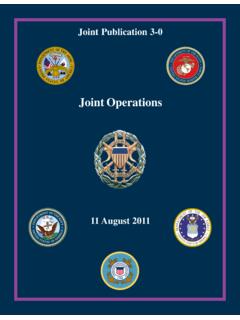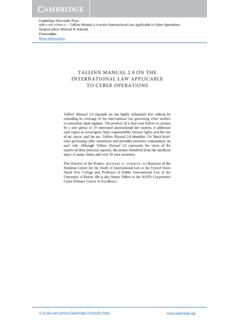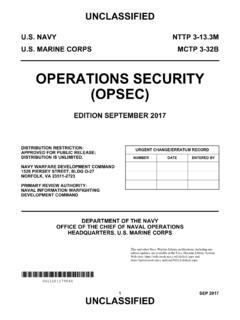Transcription of Strategy and Tactics for Initial Company Operations ...
1 STICO-Student Manual3rd Edition, 2nd Printing-July 2016 Strategy and Tactics for Initial Company OperationsStrategy and Tactics for Initial Company OperationsFEMA/USFA/NFASTICO-SMJuly 20163rd Edition, 2nd PrintingSTICO-Student Manual3rd Edition, 2nd Printing-July 2016 Strategy and Tactics for Initial Company OperationsThis Student Manual may contain material that is copyright protected. USFA has been granted a license to use this material only for NFA-sponsored course deliveries as part of the course materials, and it shall not be duplicated without consent of the copyright holder. States wishing to use these materials as part of state-sponsorship and/or third parties wishing to use these materials must obtain permission to use the copyright material(s) from the copyright holder prior to teaching the course.
2 This page intentionally left blank. Strategy AND Tactics FOR Initial Company Operations iii TABLE OF CONTENTS PAGE Table of Contents .. iii Acknowledgments .. v Course Goal .. vii Audience, Scope and Course Purpose .. vii Grading Methodology .. vii Schedule .. ix Firefighter Code of Ethics .. xi A Student Guide to End-of-course Evaluations .. xiii UNIT 1: INCIDENT COMMAND SYSTEM AND THE COMMAND SEQUENCE .. SM 1-1 Appendix: Primary Factors Size-Up Chart UNIT 2: FIRE CONFINEMENT, EXPOSURE PROTECTION, AND FIRE EXTINGUISHMENT .. SM 2-1 UNIT 3: RESCUE, VENTILATION, SUPPORT AND OVERHAUL .. SM 3-1 UNIT 4: WATER SUPPLY, FIXED FIRE PROTECTION SYSTEMS, AND SALVAGE .. SM 4-1 Bibliography Acronyms Strategy AND Tactics FOR Initial Company Operations iv This page intentionally left blank.
3 Strategy AND Tactics FOR Initial Company Operations v ACKNOWLEDGMENTS The development of any National Fire Academy (NFA) course is a complex process aimed at providing students with the best possible learning opportunity we can deliver. There are many players in course development, each of whom plays an equally important part in its success. We want to acknowledge their participation and contribution to this effort and extend our heartfelt thanks for making this quality product. The following people participated in the creation of this course: Russell Kuck Instructional Systems Specialist Curriculum and Instruction Branch Fire Administration, National Fire Academy Emmitsburg, Maryland Robert J. Bennett Training Specialist Fire Administration, National Fire Academy Emmitsburg, Maryland Timothy Smith Project Manager Cybermedia Technologies Inc.
4 Reston, Virginia Lea Mulligan Instructional Designer Cybermedia Technologies Inc. Reston, Virginia Jerry Ball Subject Matter Expert Fire Chief, Retired Cadillac, Michigan Robert Swarthout Subject Matter Expert Assistant Chief, Retired Haymarket, Virginia Strategy AND Tactics FOR Initial Company Operations vi This page intentionally left blank. Strategy AND Tactics FOR Initial Company Operations vii COURSE GOAL The goal of the course is to develop the management skills needed by Company Officers (COs) to accomplish assigned Tactics for structure fires. AUDIENCE, SCOPE AND COURSE PURPOSE The primary target audience for the Strategy and Tactics for Initial Company Operations (STICO) course is: Newly promoted COs. Excellent review for experienced COs.
5 Firefighters who may have acting CO responsibilities. Firefighters who want to become COs. The course is designed for newly promoted COs to learn the use and understanding of strategies and Tactics and their importance in ensuring firefighter safety on the fireground. GRADING METHODOLOGY Course Grade The required performance to successfully complete the course is attained by completing the examination with at least a C by answering correctly a minimum of 21 out of 30 questions. The following course grading plan should be used to determine the assigned course grade for each student in the class. Letter Grade Point Range A 90-100 B 80-89 C 70-79 F 69 or lower Strategy AND Tactics FOR Initial Company Operations viii This page intentionally left blank.
6 Strategy AND Tactics FOR Initial Company Operations ix SCHEDULE TIME DAY 1 DAY 2 8:00 - 9:45 Introduction, Welcome and Administrative Unit 2: Fire Confinement, Exposure Protection, and Fire Extinguishment (cont d) Unit 3: Rescue, Ventilation, Support and Overhaul 9:45 - 10:00 Break Break 10:00 - 10:45 Unit 1: Incident Command System and the Command Sequence Activity 31: Rescue Tactics Unit 3: Rescue, Ventilation, Support and Overhaul (cont d) 10:45 - 11:00 Break Break 11:00 - 12:00 Unit 1: Incident Command System and the Command Sequence (cont d) Activity : Ventilation Unit 3: Rescue, Ventilation, Support and Overhaul (cont d) Unit 4: Water Supply, Fixed Fire Protection Systems, and Salvage 12:00 - 1:00 Lunch Lunch 1:00 - 2:15 Unit 1: Incident Command System and the Command Sequence (cont d) Unit 2: Fire Confinement, Exposure Protection, and Fire Extinguishment Activity : Water Supply Operations Unit 4: Water Supply, Fixed Fire Protection Systems, and Salvage (cont d) 2:15 - 2:30 Break Break 2:30 - 5:00 Activity : Fire Confinement Unit 2: Fire Confinement, Exposure Protection, and Fire Extinguishment (cont d) Activity : Fire Confinement and Exposure Protection Activity : Salvage Unit 4: Water Supply, Fixed Fire Protection Systems, and Salvage (cont d) Final Exam Strategy AND Tactics FOR Initial Company Operations x This page intentionally left blank.
7 Strategy AND Tactics FOR Initial Company Operations xi Strategy AND Tactics FOR Initial Company Operations xii Strategy AND Tactics FOR Initial Company Operations xiii This page intentionally left blank. Strategy AND Tactics FOR Initial Company Operations UNIT 1: INCIDENT COMMAND SYSTEM AND THE COMMAND SEQUENCE TERMINAL OBJECTIVE The students will be able to: Identify an organized approach to safely managing incident scenes. ENABLING OBJECTIVES The students will be able to: Discuss the Incident Command System (ICS). Analyze the Command Sequence Action Cycle. Identify the types of building construction. Identify how fire behavior factors affect objectives and strategies. INCIDENT COMMAND SYSTEM AND THE COMMAND SEQUENCE SM 1-2 This page intentionally left blank.
8 INCIDENT COMMAND SYSTEM AND THE COMMAND SEQUENCE SM 1-3 UNIT 1:INCIDENT COMMAND SYSTEM AND THE COMMAND SEQUENCES lide 1-1 Discuss the Incident Command System (ICS). Analyze the Command Sequence Action Cycle. Identify the types of building construction. Identify how fire behavior factors affect objectives and 1-2 ENABLING OBJECTIVES I. MAJOR FUNCTIONS OF THE INCIDENT COMMAND SYSTEM MAJOR FUNCTIONS OF THE INCIDENT COMMAND SYSTEM Command is responsible for overall incident management: Size up. Identify problems. Establish objectives. Determine strategies. Select Tactics . Set the Incident Action Plan (IAP).Slide 1-3 INCIDENT COMMAND SYSTEM AND THE COMMAND SEQUENCE SM 1-4 A. Command is responsible for overall incident management.
9 B. Responsibilities of command. 1. Size up. 2. Identify problems. 3. Establish objectives. 4. Determine strategies. 5. Select Tactics . 6. Set the Incident Action Plan (IAP). MAJOR FUNCTIONS OF THE INCIDENT COMMAND SYSTEM (cont d) Develop ICS organization. Manage resources. Coordinate resource activities. Provide for safety. Release information. Coordinate with outside 1-4 7. Develop appropriate Incident Command System (ICS) organization. 8. Manage resources. 9. Coordinate resource activities. 10. Provide for safety. 11. Release information. 12. Coordinate with outside agencies. INCIDENT COMMAND SYSTEM AND THE COMMAND SEQUENCE SM 1-5 EXPANDING ELEMENTS OF INCIDENT COMMAND SYSTEMSome to assignment, the rest to UNITSTAGINGFIRE ATTACK GROUPRESCUE GROUPVENT GROUPSALVAGE GROUPS lide 1-5 C.
10 Expanding elements of ICS. 1. How will they be distributed? 2. All to Staging; all to fire; some to each. 3. Let s end with a total of seven units at the scene and look at the ICS chart on the slide. EXPANDING ELEMENTS OF INCIDENT COMMAND SYSTEM (cont d)What is wrong with the organization?REHABE-3PM-2E-1E-4E-2T-2T-1 E-5PM-1 COMMANDRICMED UNITSTAGINGFIRE ATTACK GROUPRESCUE GROUPVENT GROUPSALVAGE GROUPFIRE ATTACK GROUPRESCUE GROUPS lide 1-6 INCIDENT COMMAND SYSTEM AND THE COMMAND SEQUENCE SM 1-6 EXPANDING ELEMENTS OF INCIDENT COMMAND SYSTEM (cont d)Division Supervisor directs resources within a geographic area of UNITSTAGINGDIVISIONGROUPREHABCOMMANDSAFE TYRICMED UNITSTAGINGDIVISIONGROUPOPERATIONSS lide 1-7 4. Division Supervisor.





